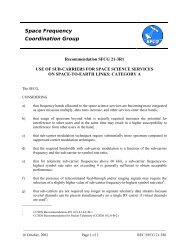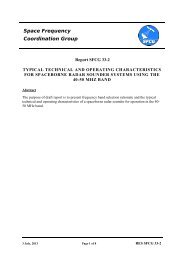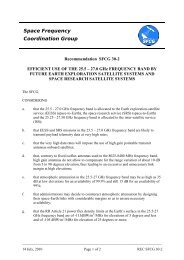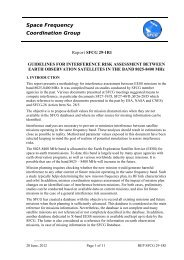Space Frequency Coordination Group - SFCG
Space Frequency Coordination Group - SFCG
Space Frequency Coordination Group - SFCG
- No tags were found...
Create successful ePaper yourself
Turn your PDF publications into a flip-book with our unique Google optimized e-Paper software.
<strong>Space</strong> <strong>Frequency</strong><strong>Coordination</strong> <strong>Group</strong>Recommendation <strong>SFCG</strong> 22-1R1FREQUENCY ASSIGNMENT GUIDELINES FOR COMMUNICATIONSIN THE MARS REGIONThe <strong>SFCG</strong>,CONSIDERINGa) that a regional communication network can be expected in the foreseeable future at Marsas missions to Mars increase in number and variety;b) that frequencies for direct communication between a spacecraft at Mars and an Earthstation are provided in the existing allocations to the space research service (SRS);c) that separate frequencies are needed in the Mars region for compatible localcommunications between a surface vehicle and an orbiter, between surface vehicles, andbetween orbiters;d) that major criteria for allocating frequencies include RF compatibility, technologyavailability and performance, operation scenarios, cost to the missions, and ability toconduct testing and emergency support from the Earth;e) that, without sufficient frequency separation, a Mars vehicle receiving signals from theEarth can be easily interfered by a signal transmitted by itself or by a local Mars vehicle,and a Mars vehicle transmitting to the Earth can easily interfere with a local receiver;f) that lower frequency provides better SNR performance for a communication link betweentwo vehicles using low gain broad beam antennas, such as between a rover and a loworbiter;g) that higher frequency provides better performance between two vehicles employing highgain antennas, such as between a large lander and an orbiter with accurately pointedantennas;h) that testing Mars local link radios with signals transmitted from an earth station is allowedonly if it does not interfere with Earth-based radio systems operating in accordance with___________________________________________________________________________25 September, 2003 Page 1 of 8 REC <strong>SFCG</strong> 22-1R1
provisions of Radio Regulations; and that techniques such as self test on board areavailable to minimize the need for testing with Earth-based signals;i) that the <strong>SFCG</strong> has resolved to provide assistance to member agencies in coordinatingfrequency assignment for deep space missions, including missions to Mars (see RES<strong>SFCG</strong> A 21-1);j) that Mars missions need interoperable relay links to maintain communication with theEarth; and that such links in the UHF band have been defined in the CCSDS Proximity 1standard;k) that passive observations in space need to be protected to the extent provided in the RadioRegulations, particularly the quiet zone in the shielded area of the Moon.RECOGNISINGa) that Mars local links must not interfere with the direct communication links between spaceand the Earth using frequencies provided in the ITU Radio Regulation;b) that multiple frequency bands are needed for missions to meet various communicationsrequirements and satisfy cost, mass and performance objectives.RECOMMENDS1. that agencies select frequencies from Table 1 for communications in the Mars regionaccording to the specific applicability and precautions recommended in Table 2,2. that testing Mars local links in flight with signals transmitted from an Earth station beminimized and strictly non-interfering to the Earth-based radio systems operating underthe provisions of Radio Regulation;3. that assignment of Mars local link frequencies be coordinated within the <strong>SFCG</strong> inaccordance with RES A 21-1.___________________________________________________________________________25 September, 2003 Page 2 of 8 REC <strong>SFCG</strong> 22-1R1
Table 1: Summary of <strong>Frequency</strong> Bands for Communications in the Mars Region<strong>Space</strong>-to-Earth:LinkEarth-to-space :Orbit-to-surface:Surface-to-orbit:Surface-to-surface:Orbit-to-orbit:Approach Navigation &Atmosphere Radio Science:2290-2300 MHz8400-8450 MHz31.8-32.3 GHz2110-2120 MHz7145-7190 MHz34.2-34.7 GHz435-450 MHz**2025-2110 MHz7190-7235 MHz14.5-15.35 GHz<strong>Frequency</strong>390-405 MHz**2200-2300 MHz8400-8500 MHz*16.6-17.1 GHz435-450 MHz390-405 MHz2025-2120 MHz2200-2300 MHz435-450 MHz390-405 MHz2025-2120 MHz2200-2300 MHz7190-7235 MHz8450-8500 MHz8400-8450 MHzMultiple frequency bands are provided in Table 1 for each communication link. Table 2 presents specificrecommendations on the use of these bands, including the merits and precautions that should beconsidered before choosing a band.Figure 1 presents a graphic illustration of the vehicles and communication links, and a conceptual futurescenario with frequency bands chosen from Table 1.Note* - Using this band for the surface-to-orbit link is permitted in the near future when users are few. Auser must coordinate with missions using the band for the <strong>Space</strong>-to-Earth link and operate on non-interferingbasis. A user mission to be launched after January 1, 2015 must seek a waiver from the <strong>SFCG</strong>.Note** - Operation in the reverse direction is permitted in the near term when users are few. A user mustcoordinate with missions using the band in the proper direction and operate on non-interfering basis. A usermission to be launched after January 1, 2010 must seek a waiver from the <strong>SFCG</strong>.___________________________________________________________________________25 September, 2003 Page 3 of 8 REC <strong>SFCG</strong> 22-1R1
A Conceptual Scenario Circa 2010(Numbers indicated represent frequency bands, in GHz, selected from Table 1)OtherOrbitersOrbit-to-Orbit0.4, 7-8OrbiterApproach navigation8.4VehicleApproachingMarsOrbit-to-Surface0.4F, 7.2<strong>Space</strong>-to-Earth32, 8.4Earth-to-<strong>Space</strong>7.1Surface-to-Orbit0.4R, 8.4*, 8.5, 16EarthRoverSurface-to-Surface0.4, 2.1-2.2LanderE-to-S 7.1S-to-E 8.4* only in near term when users are fewPlanet MarsFigure 1Note: In Figure 1, the numbers in GHz represents a subset of frequency bands from Table 1, as follows:“0.4” = 390-405; 435-450 MHz“0.4F” = 435-450 MHz“0.4R” = 390-405 MHz“2.1-2.2” = 2025-2120; 2200-2300 MHz“7.1” = 7145-7190 MHz“7.2” = 7190-7235 MHz“7-8” = 7190-7235; 8450-8500 MHz“8.4” = 8400-8450 MHz“8.5” = 8450-8500 MHz“16” =16.6-17.1 GHz“32” = 31.8-32.3 GHz___________________________________________________________________________25 September, 2003 Page 4 of 8 REC <strong>SFCG</strong> 22-1R1
Table 2: Notes on The Mars Local Link Frequencies Recommended in Table 1 October 11, 2002General Comments:1. All present and planned future missions to Mars use X-Band S-to-E and E-to-S links.2. A few missions also carry S-Band S-to-E or E-to-S links. The S-Band uplink is restricted by IMT2000.3. For all frequencies on this table, technology or equipmrnt is available in the industry.4. Saturation or jamming refers to strong interfering signal overwhelming the receiver operating in the same band or adjacent band. For missions at Mars satuationhappens only on the same vehicle, not likely between vehicles because of the large distance between them.5. Cross interference refers to interference from one vehicle to another. For Mars missions, such interference is not likely to occur in the adjacent band.Data RatePerformanceAccurateAntennaPointing forPerformanceMass andVolumePossible EquipmentSharing with Deep<strong>Space</strong> <strong>Space</strong>-EarthLinksSelf-Interference withDeep <strong>Space</strong> <strong>Space</strong>-Earth LinksCross Interferencewith Deep <strong>Space</strong><strong>Space</strong>-Earth LinksTesting withSignalsTransmitted froman Earth StationComments1.0 <strong>Space</strong>-to-Earth(S-to-E)Per ITU-R RR2.0 Earth-to-<strong>Space</strong>(E-to-S)Per ITU-R RR3.0 Orbit-to-Surface(Command)3.1 435-450 MHzBest at lowrate, withLGANot requiredwith LGA large none none noneOnly on noninterferingbasis(NIB)For low ratelinks3.2 2025-2110 MHzHigh rate,withMGA/HGARequiredwith smallbeamwidth(A)smallIf the lander carries anS-Band E-S receiver(Note: Deep space E-to-S is restricted byIMT2000) it is possibleto modify the receiverto operate at extendedfrequencies.If the orbiter carries S-Band E-S, the S-Bandlocal link transmittercould saturate the S-Band E-S receiverunless there isadequate isolation.none<strong>Coordination</strong> iseasier, as theband is allocatedto SRS E-S, nearEarth, wheresimilartransmissionsoperate, althoughat lower power.For high ratelinks. Can'tshare X-Bandequipment.______________________________________________________________________________________________________________________25 September, 2003 Page 5 of 8 REC <strong>SFCG</strong> 22-1R1
3.3 7190-7235 MHz3.4 14.5-15.35 GHzHigher rate,with HGAEven higherrate than X-Band, withHGARequiredwith smallerbeamwidth(1/4 A) smallerRequiredwith evensmallerangle (1/8A)Possible to modify theX-Band E-to-Sreceiver to operate atextended frequencies.The orbiter X-Bandlocal link transmittercould saturate anorbiter X-Band E-Sreceiver unless thereis adequate isolation.noneevensmallerthan X-Band none none none NIBHigh powertransmission inurban area isrestricted toprotect fixed andmobile services. Alesser problem inrural areas.For high ratelinks. Canshare X-Bandequipment.Must avoidselfinterferencetothe X-Band E-to-S linkFor high ratelinks4.0 Surface-to-Orbit(Telemetry)4.1 390-405 MHz see 3.1 see 3.1 see 3.1 none none none NIBIf the lander carriersS-Band S-Etransmitter (2290- An orbiter S-Band S-2300 MHz), it is to-E transmitter couldpossible to modify the saturate the orbitertransmitter to operate local link receiverat extendedunless there is4.2 2200-2290 MHz see 3.2 see 3.2 see 3.2 frequencies.adequate isolation. none NIBFor low ratelinksFor high ratelinks. Not asgood as 4.4which allowsX-Bandequipmentsharing.4.3 2290-2300 MHz see 3.2 see 3.2 see 3.2If the lander carries S-Band S-to-Etransmitter, the locallink can share thetransmitter withoutmodification.An orbiter S-Band S-Elink transmitter willsaturate the orbiter S-Band local linkreceiver.An orbiter with S-Band S-to-E linkcould interfere withthe local link receiverif the latter is in itsantenna beam.NIBFor high ratelinks. Not asgood as 4.4which allowsX-Bandequipmentsharing.4.4 8400-8450 MHz see 3.3 see 3.3 see 3.3Can share withoutmodification a landerX-Band S-to-Etransmitter.An orbiter X-Band S-Elink transmitter willsaturate the orbiter X-Band local linkreceiver.An orbiter with X-Band S-to-E linkcould interfere withanother orbiterreceiving local X-Band link if the latteris near or in itsantenna beam.NIBFor high ratelinks. Mustavoid crosslinkinterferencefrom S-E links.______________________________________________________________________________________________________________________25 September, 2003 Page 6 of 8 REC <strong>SFCG</strong> 22-1R1
4.5 8450-8500 MHz see 3.3 see 3.3 see 3.3Possible to share alander X-Band S-to-Etransmitter modifed tooperate at extendedfrequencies.4.6 16.6-17.1 GHz see 3.4 see 3.4 see 3.4 none none noneOrbiter X-Band S-to-Etransmitter couldsaturate the orbiterlocal link receiverunless there isadequate isolation. none NIBAlready allocatedto SRS, deepspace, E-to-S,secondaryFor high ratelinksFor higher ratelinks5.0 Surface-to-Surface5.1 435-450 MHz and390-405 MHz see 3.1 see 3.1 see 3.1 none none none NIB5.2 2025-2110 MHzand 2200-2290 MHzLow rate withLGA. Higherrate possiblewith MGA.LGA doesnot requirepointing.MGA does. see 3.2If lander carries S-Band space-Earthequipment, it ispossible to modify it tooperate at extendedfrequencies.If the lander uses S-Band for space-Earthlinks, there will be selfjammingbetween thespace-Earth and thelocal links unless thereis adequate isolation.noneTesting in the2025-2110 MHzband can becoordinated, as itis in SRS E-Sband. Testing inthe 2290-2300MHz band is onNIB.For low ratelinksFor higher ratelink with line ofsight.5.3 2110-2120 MHzand 2290-2300 MHz see 5.2 see 5.2 see 3.2If a lander carries anS-Band space-Earthtransmitter or receiver,it can be used for locallink.If the lander uses S-Band space-Earthlinks, there will be selfjammingbetween thespace-Earth and thelocal links.A third vehicle usingS-Band space-Earthlinks may interferewith the local linkreceiver if it is nearthe local link receiver,or there is not enoughantennadiscriminationbetween the Earthlink transmitter andthe local link receiver.The 2110-2120MHz band isalready allocatedto SRS, deepspace, E-to-S.Testing the 2290-2300 MHz is onNIB.For higher ratelink with line ofsight.6.0 Orbit-to-Orbit6.1 435-450 MHz and390-405 MHz see 3.1 see 3.1 see 3.1 none none none NIBFor low ratelinks______________________________________________________________________________________________________________________25 September, 2003 Page 7 of 8 REC <strong>SFCG</strong> 22-1R1
6.2 2025-2110 MHzand 2200-2290 MHz see 3.2 see 3.2 see 3.2If an orbiter uses S-Band space-Earthlink, it is possible tomodify space-Earthlink equipment tooperate at extendedfrequencies.If an orbiter uses S-Band space-Earthlinks, there will be selfjammingbetween thespace-Earth and thelocal links unless thereis adequate isolation.noneTesting in the2025-2110 MHzband can becoordinated, as itis in SRS E-Sband. Testing inthe 2290-2300MHz band is onNIB.For high ratelinks. Lesslikely to shareequipment.6.3 2110-2120 MHzand 2290-2300 MHz see 3.2 see 3.2 see 3.2If orbiter carries an S-Band space-Earthlink, the local link canshare the sameequipment.If one vehicle uses S-Band space-Earthlinks, there will be selfjammingbetween thespace-Earth and thelocal links on thevehicle. see 5.3The 2110-2120MHz band isalready allocatedto SRS, deepspace, E-to-S.Testing the 2290-2300 MHz is onNIB.For high ratelinks. Can notshareequipment withX-Band S-Elinks.6.4 7190-7235 MHzand 8450-8500 MHz see 3.3 see 3.3 see 3.3Possible to modify theX-Band space-Earthlink equipment tooperate in theextended frequencyrange.The X-Bandtransmitter couldsaturate the X-Bandreceiver on the samevehicle unless there isadequate isolation.noneTesting in the7190-7235 MHzband can becoordinated, as itis in SRS band.Testing in the8450-8500 MHzband is on NIB.For high ratellinks. Possibleto shareequipment withX-Band S-Elink.7.0 Mars ApproachNavigation andAtmosphere RadioScience7.1 8400-8450 MHzRadio metricmeasurementAccuratepointing asexisting onspacecraftfor Earthlink. see 3.3Sharing equipmentwith the X-Band S-to-E transmitterOrbiter doingapproach navigationdoes not operate theEarth link at the sametime. Orbiter X-BandS-to-E transmitter willsaturate the orbiterlocal link receiver.However, nosimultaneouslyoperation of the Earthlink with local link isplanned for approachnavigation.Cross Interferencewill not occur withapproach navigation.It may happen withoccultation radioscience whenreceiver is in thebeam of anotherorbiter transmittingthe S-E link.NIB______________________________________________________________________________________________________________________25 September, 2003 Page 8 of 8 REC <strong>SFCG</strong> 22-1R1
















